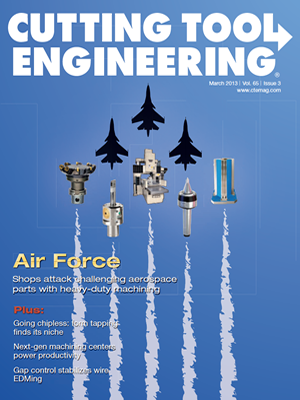Several weeks ago, my wife and I attended a dinner party at her sister’s home. One of the guests heard I was in manufacturing and introduced himself. He’s 48, married and has five children and a mortgage. He’s a pleasant individual, and we spoke about his trials and tribulations over the last few years. He lost his job during the Great Recession and has since been struggling to find a steady job. Unemployment checks and odd jobs, as well as assistance from their church and friends, have helped his family muddle along. His experience is in customer service and sales.
The fellow had come to a hard realization that it was time for a career change. A friend of his told him about a state-assisted, 16-week CNC training program at a local school. He inquired about it and was admitted into the program. The estimated cost of the program is about $8,500 per student, but students invest nothing other than their time and the gas needed to get there. Upon or near completion of the program, students receive assistance in writing resumes and are referred to machine shops looking to hire them full-time, starting at $12 to $16 per hour.
During our conversation, I became concerned that some of these short-term vocational programs are not preparing students for the real world. Sure, they teach the requisite math, blueprint reading and G and M codes, but some important things seem to be missing.
n Are these programs teaching any manual machining skills? Everything I heard about the 16-week program referred to CNCs. However, you learn basic setups on manual machines. The dinner guest asked me what I thought was the most important part of machining. When I said setups, his jaw dropped. Without a good setup, you’re dead in the water. You can understand the math and have the correct feeds and speeds, but if the part is not secure and the job repeatable, you’re going to produce a lot of scrap. The only milling fixture covered in the program was a vise, but more setups are created without a vise than with one.
n Are these programs taking students to machine shops to see what they can expect in the real world? Ideally, they should do this during the first week of training so people know what they are getting into. Although I’ve worked in hole-in-the-wall shops that left me covered with rashes, I’ve also worked in shops where you could almost eat off the floor. I currently work in a temperature-controlled facility that has mist collectors on the machines and epoxy-coated floors for easy maintenance.
n Are these programs providing an accurate estimate of wages and potential positions in the manufacturing industry? My new acquaintance was pleasantly surprised at what machinists can earn, especially with overtime. In addition, promotions are available to diligent entry-level workers in the long run. That’s where many applications engineers, programmers, manufacturing engineers and sales engineers come from. Mind you, I’m not trying to take anything away from the engineers who’ve earned their degrees, but even some degreed engineers have received their best training on the shop foor. And let’s not forget that many machine shop employees eventually own their own shops!
These vocational training programs shouldn’t just “churn and burn.” They need to make sure the students have their eyes wide open and know what they are getting into. CTE
About the Author: Mike Deren is a manufacturing engineer/project manager and a regular CTE contributor. He can be e-mailed at [email protected].Related Glossary Terms
- computer numerical control ( CNC)
computer numerical control ( CNC)
Microprocessor-based controller dedicated to a machine tool that permits the creation or modification of parts. Programmed numerical control activates the machine’s servos and spindle drives and controls the various machining operations. See DNC, direct numerical control; NC, numerical control.
- fixture
fixture
Device, often made in-house, that holds a specific workpiece. See jig; modular fixturing.
- gang cutting ( milling)
gang cutting ( milling)
Machining with several cutters mounted on a single arbor, generally for simultaneous cutting.
- milling
milling
Machining operation in which metal or other material is removed by applying power to a rotating cutter. In vertical milling, the cutting tool is mounted vertically on the spindle. In horizontal milling, the cutting tool is mounted horizontally, either directly on the spindle or on an arbor. Horizontal milling is further broken down into conventional milling, where the cutter rotates opposite the direction of feed, or “up” into the workpiece; and climb milling, where the cutter rotates in the direction of feed, or “down” into the workpiece. Milling operations include plane or surface milling, endmilling, facemilling, angle milling, form milling and profiling.


